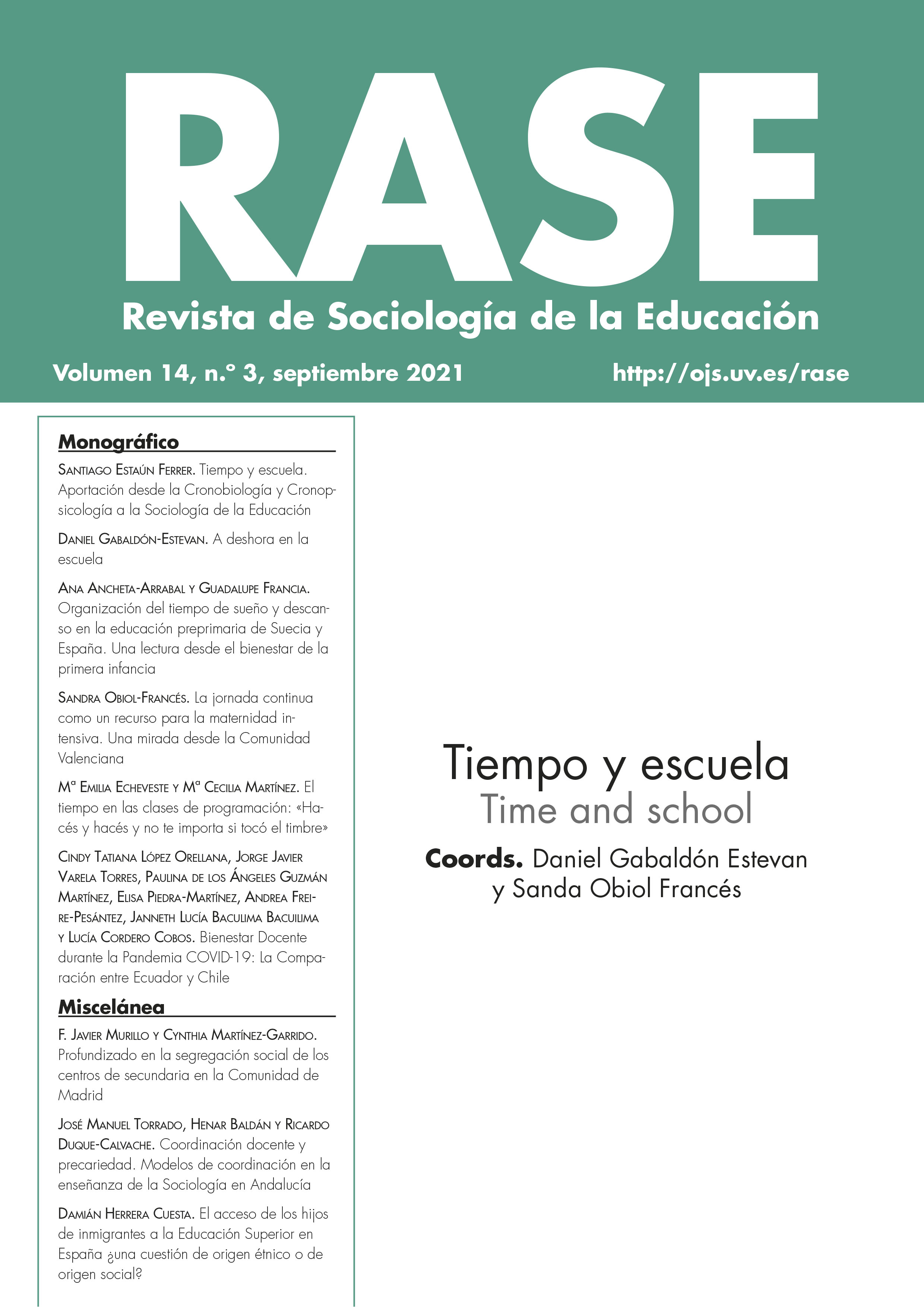Time and School. Contribution from Chronobiology and Chronopsychology to the Sociology of Education. Notes for Reflection
DOI:
https://doi.org/10.7203/RASE.14.3.21631Keywords:
Cronobiología, cronopsicología, ritmos atencionales, ritmos memoria, sueño, hemisferio derecho, hemisferio izquierdo Abstract
Abstract
The concern for a correct organization of school schedules focuses on the what (curriculum), the how (methodology) and when to teach, but this when it focuses most of the time on how to distribute the subjects to the throughout the day, or in the type of school day. Chronobiology and chronopsychology focus their gaze on the organization of the activity of the living being, the person, and provide knowledge about the optimal moments of certain activities and the convenience of respecting them within adaptive margins, such as activation and rest /sleep, attentional rhythm, memory, and intellectual activity as a whole, showing the complexity of their integration respecting the biological clock as well as integrating it socio-culturally, of a person in continuous change.
 Downloads
Downloads
 References
References
Acuña Castroviejo, Darío (2018). Sueño y Vigilia. EMSE EDAPP, S.L. Madrid.
Agostino PA; Plano SA. y Golombek DA. (2007). Sildenafil accelerates reentrainment of circadian rhythms., Proc National Academy of Sciences, 104(23): 9834-9839.
Akerstedt, T. y Fröberg, J.E. (1976). Interindividual differences in circadian patterns of cathecolamine excretion, body temperatura, performance and subjective arousal. Biological Psychology, 4, 277-292.
Beugnet-Lambert, C. (1985). Vigilance et cognition: aproche chronopsychologique de l’attention. Thèse doctorat de Psychologie. Université de Lill3: Lille
Beugnet-Lambert, C.; Lancry, A. & Leconte, P. (1988) Chronopsychologie. Rythmes et activités humaines. Lille: Presses Universitaires de Lille 3
Blake, M.J.F. y Corcoran, D.W.J. (1971) Introversion – extroversión and circadian rhythms, en Colcuhoun, W.P. Biological rhythms and performance London: Academic Press, 261-272.
Bloch, V. (1973). Les niveaux de vigilance et l’attention, en Fraisse, P. y Piaget, J. Traité de Psychologie Expérimentale, tomo 3, 83-130.
Bloch, V.; Denti, A.y Schmaltz, G. (1966). Effets de la stimulation réticulaire sur la phase de consolidation d’un apprentissage à essai unique par estimulation réticulaire. Journal of Physiology, 58, 469-470.
Bloch, V.; Deweer, B. y Hennevin, E. (1970). Suppression de l’amnésie rétrograde et consolidation d’un apprentissage à essai unique par stimulation réticulaire. Physiology and Behaviour, 5, 1235-1241.
Canals, R.; Añaños, E. y Martín, M. (1989).Ritmes circadians de l’atenció en una mostra d’alumnes de cicle mitjà. Butlletí Universitari de Psicologia,IV, (5) 13-15.
Crépon, Pierre (1983). Les rythmes de vie de l’enfant. Retz: Paris.
Folkard, S. (1980). A note on “time of dayeffects in schoolchildren’sinmediate ad delayedrecall of meaning full material” – the influence ofthe importanceof the informationtested. British Journal of Psychology. 71, 95-97.
Folkard, S.; Bradury, R. y Rosenthall, J. (1977). Time of day effects in school children’s inmediate and delayed recall of meaning full material. British Journal of Psychology. 68, 45-50.
Gates, A. I. (1916). Variations in efficiency during the day, together with practice effects, sex differences and correlations. University of California Publications in Psychology, 2, 1-156.
Hederich, C.; Camargo, A. y Reyes, M. E. (2004) Ritmos cognitivos en la escuela. Bogotá: Universidad Pedagógica Nacional, División de Gestión de Proyectos, Centro de Investigaciones.
Hennevin, E. y Leconte, P. (1977). Étude des relations entre le somneil paradoxal et les processus d’adquisition.Physiology and Behaviour. 18, 307-319.
Horne, J. A. y Ostberg, O. (1977). Individual differences in human circadian rhythms. Biological Psychology. 5, 179-190.
Horne, J. A.; Brass, C. G. y Pettitt, A. N. (1980). Circadian performance differences between morning and evening types. Ergonomics, 23, (1), 29-36.
Hughes, D. G. y Folkard, S. (1976). Adaptation to an 8-h. shift in living routine by members of a socially isolated community. Nature, 264,432-434.
Klein, R & Armitage, R. (1979). Rhytms in human performance: 1:1/2 hour oscillations in cognitive style. Science, 204, 1326-1328.
Leconte, P. (1989). La Chronopsychologie. PUF: Paris-
Leconte, C. (2011). Des rythmes de vie aux rythmes scolaires. Septentrion: Villeneuve d’Ascq.
Meccaci, Luciano (1985) Radiografía del cerebro. Barcelona: Ariel (trad. Jordi Marfà del italiano Identikit del cervello, 1984)
Mills, J.N. (1964). Circadian rhythms duringand afterthree months in solitude underground, Journal Physiolog, 174, 217-231
Pöppel, E.; Aschoff, J. C.; yGiedke, H. (1970). Tagesperiodische Veränderungen der Reaktionszeit bei Wahlreaktionen. Zeitschrift für Experimentelle und Angewande Psychologie, XVII, 537-552.
Roffwarg, F.; Muzio, J. y Dement, W. (1966). Ontogenetic development of the human sleep dream cycle. Science, 152, 604-619.
Sáiz, D. (1988). Una aproximación a los ritmos de la memoria.Tesis doctoral. Facultad de Filosofía y Letras. Universitat Autònoma de Barcelona. Bellaterra.
Sáiz, D y Estaún, S. (1990). Apreliminary studi of the rhythms in different tasksof memory. En Morgan, E. (edt). Chronobiology and Chronomedicine. Basic Researchand Applications. 310-317. Peter Lang: Frankfurt.
Siffre, M. (1963). Hors du temps. Julliard: Paris.
Testu, F. (1987). Chronopsychologie et rythmes scolaires.Etude expérimentale.Poitiers
Testu, F. (1989). Chronopsychologie et rythmes scolaires. Masson: Paris
Testu, F. (1993) Etude des rythmes scolaires en Europe. Paris: Ministère de l’Education Nationale
Thatcher, R.W.; Walker, R.A. & Giudice, S. (1987) Human cerebral hemispheres develop at different rates and ages. Science. 236. 1110-1113
Vermeil, Guy (1976). L fatigue à l’école. ESP: Paris
Downloads
Published
How to Cite
-
Abstract895
-
PDF (Español)483
Issue
Section
License
![]()
This work is licensed under a Creative Commons Reconocimiento-NoComercial-CompartirIgual 4.0 Internacional.




